Approximation & Errors
advertisement
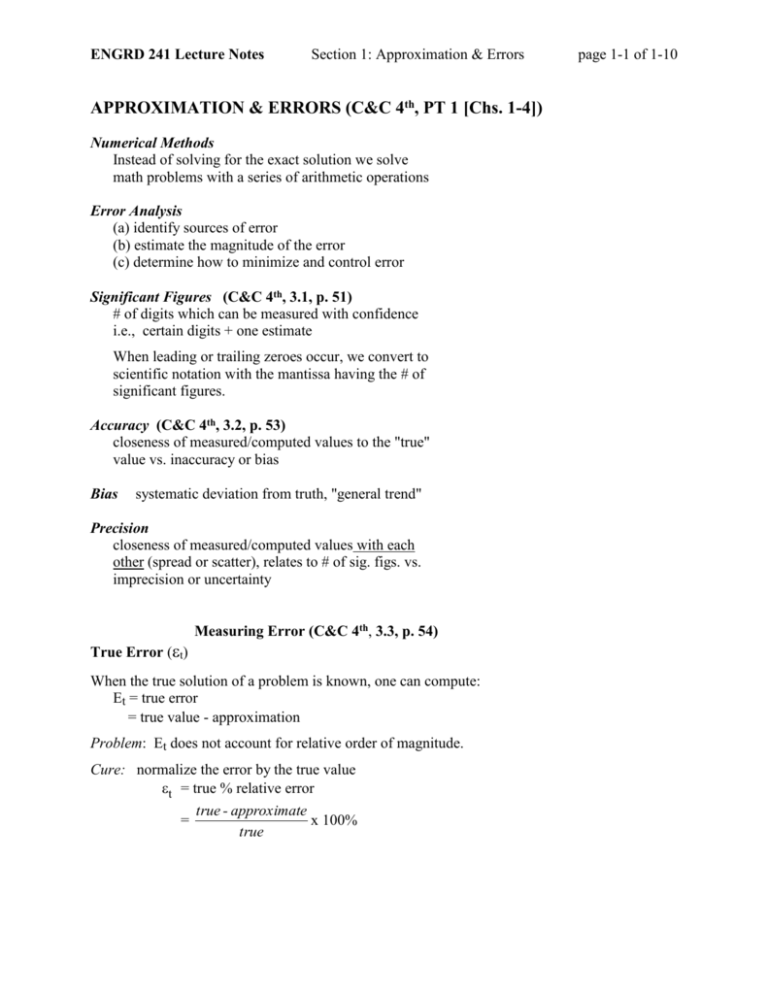
ENGRD 241 Lecture Notes
Section 1: Approximation & Errors
APPROXIMATION & ERRORS (C&C 4th, PT 1 [Chs. 1-4])
Numerical Methods
Instead of solving for the exact solution we solve
math problems with a series of arithmetic operations
Error Analysis
(a) identify sources of error
(b) estimate the magnitude of the error
(c) determine how to minimize and control error
Significant Figures (C&C 4th, 3.1, p. 51)
# of digits which can be measured with confidence
i.e., certain digits + one estimate
When leading or trailing zeroes occur, we convert to
scientific notation with the mantissa having the # of
significant figures.
Accuracy (C&C 4th, 3.2, p. 53)
closeness of measured/computed values to the "true"
value vs. inaccuracy or bias
Bias
systematic deviation from truth, "general trend"
Precision
closeness of measured/computed values with each
other (spread or scatter), relates to # of sig. figs. vs.
imprecision or uncertainty
Measuring Error (C&C 4th, 3.3, p. 54)
True Error (t)
When the true solution of a problem is known, one can compute:
Et = true error
= true value - approximation
Problem: Et does not account for relative order of magnitude.
Cure: normalize the error by the true value
t = true % relative error
true - approximate
=
x 100%
true
page 1-1 of 1-10
ENGRD 241 Lecture Notes
Section 1: Approximation & Errors
Approximate Error (a)
Suppose solving a sequence of approximations or iterative calculations
that is converging toward the correct solution.
When you don't know true (more often the case!), approximate the error in
the same way we approximated the solution:
a =
Present Approx. - Previous Approx.
x 100%
Present Approx.
This expression can be inaccurate as estimator of t.
Stopping Error (s)
We could stop an iterative procedure when
|a| < s
where s is our convergence criteria. To achieve n significant digits of
accuracy, one might use
s = (0.5 x 102-n) %
(NOTE: 102 is required because the result is a percent)
SOURCES OF ERROR
1. Idealization errors
a) Theory and/or Model Formulation
b) Data uncertainty
* c) Discretization inadequacies
2. Input Errors (blunders)
3. Process Errors (algorithm dependent)
a) Blunders, logic errors
* b) Truncation (convergence/stability)
4. Manipulation Errors
* a) Round-off
* b) Cancellation, critical arithmetic
5. Output Errors
a) Blunders (wrong output)
b) Interpretation
[C&C 4th, 4.4.2]
[C&C 4th, 4.4.3]
[C&C 4th, 4.4.1]
[C&C 4th, 4.4.1]
[C&C 4th, 4.1]
[C&C 4th, 3.4]
[C&C 4th, 3.4.2]
[C&C 4th, 4.4.1]
*These items are interrelated and will be treated extensively in this course.
page 1-2 of 1-10
ENGRD 241 Lecture Notes
Section 1: Approximation & Errors
Primary Error Types in Numerical Solutions:
Round-off Errors
limited # of sig. digits that can be retained by computer
Truncation Errors
due to approximation of numerical method employed
Round-off Errors (C&C 4th, 3.4, p. 57)
Representing a Floating Point #:
divide n bit word into +/-, signed exponent, and mantissa
+/signed exponent
mantissa
which refers to
± m be
m is mantissa
b is base of # system, i.e., 2, 10, ...
e is exponent
normalize to exclude "useless" zeros so mantissa satisfies
1
m 1
b
for binary: 0.5 < m < 1
decimal: 0.1 < m < 1
EXAMPLE: Base 10 Machine:
This "Machine" carries three sig. decimal digits and one exponent digit
after normalization.
± 0.DDDE ± e
with:
0 < e <9
100 < DDD < 999
We represent – 0.02778 in our machine:
– 0.277E-1 w/ chopping
t = 0.29%
– 0.278E-1 w/ rounding
t = 0.07%
(most computers round, but some chop to save time)
page 1-3 of 1-10
ENGRD 241 Lecture Notes
Section 1: Approximation & Errors
Consequences of Computer Representation of #'s:
Limited Range of quantities can be represented because there are a
finite # of digits in both the mantissa and the exponent.
"our machine" example:
smallest positive #:
largest positive #:
0.100E-9 or 10 - 10
0.999E+9 10 + 9
Finite # of floating point values can be represented within above range.
"our machine" example:
± (0.100 to 0.999) E-9 to E+9
2
900 #'s
19 #'s = 34,200 #'s
plus zero ( 0.000 E±D)
Thus, a total of 34,201 #'s can be represented within the above
range (zero appears only once).
The interval between successive represented #'s (quantization error) is
not uniform and increases as the numbers grow in magnitude.
– "quantization" error, x, is proportional to the magnitude x.
@ 0.312E+1 | x | = 0.01
@ 0.312E+4 | x | = 10.0
– normalizing | x | by |x| approximates the "machine epsilon"
Machine Epsilon:
Smallest number such that: 1 + > 1
x
with chopping
x
Quick formula [Eq. (3.11), p. 64, correct for chopping only]:
= b1-t for a machine with chopping [ = b-t for rounding]
where: b = base system
t = number of sig. figs. in mantissa
Trouble happens when you – (C&C 4th, 3.4.2, p. 66)
Add (or subtract) a small number to a large number.
Small numbers get lost.
Remedy: add or subtract small numbers together first.
Subtract numbers of almost equal size (subtractive cancellation).
Too few significant digits left.
Both can happen.
Consider series expansion of exp(x) for x = –10 (smearing). See
C&C, Ex. 3.8 and Fig. 3.12, p. 70-71, where negative values of
exp(-10) are possibly computed due to smearing.
page 1-4 of 1-10
ENGRD 241 Lecture Notes
Section 1: Approximation & Errors
Modern Computers (IEEE standard):
Single Precision:
32 BIT WORDS
24 BITS assigned to mantissa
(First bit assumed to = 1 and not stored.)
8 BITS to signed exponent
Double Precision:
64 BIT WORDS
56 BITS assigned to mantissa
8 BITS to signed exponent
223 = 8,400,000 or almost 7 full decimal digits
255 = 4x1016 or almost 17 decimal digits
27 – 1 = 127; 2+127 ~ 2x1038
(Be careful here as to how sign and number are represented.)
Truncation Error
Error caused the by nature of numerical technique employed to
approximate the solution
Taylor Series Expansion (C&C 4th, 4.1, p. 73)
Basic Idea:
Predict value of a function, f, at a point xi+1 based on the value of a
function and all of its derivatives, f, f ', f ",… at a neighboring point xi
General Form (Eq. 4.7 in C&C)
h2
h3
hn n
f(xi+1) = f(xi) + hf '(xi) +
f "(xi) +
f "'(xi) + … +
f (xi) + Rn
2!
3!
n!
with
h = "step size" = xi+1 – xi
Rn= remainder to account for other terms
=
h n 1 n+1
f () where xi < < xi+1
(n 1)!
= O (hn+1) with not exactly known
"on the order of hn+1"
Note: f(x) must be a function with n+1 continuous derivatives
page 1-5 of 1-10
ENGRD 241 Lecture Notes
Section 1: Approximation & Errors
page 1-6 of 1-10
Numerical Differentiation from Taylor Series Expansion (C&C 4th, 4.1.3, p. 85)
Objective:
Evaluate the derivatives of function, f (xi), without doing it analytically.
When would we want to do this?
1. function is too complicated to differentiate analytically
2. function is not defined by an equation (data points)
Backward Difference Approx.:
First Derivative:
f (xi–1) = f (xi) + (xi–1 – xi) f '(xi) +
h2
f "()
2!
with
h = xi – xi-1
h2
f "()
2!
h2
h f '(xi) = f (xi) – f (xi–1) +
f "()
2!
f (xi–1) = f (xi) – hf '(xi) +
f '(xi) =
f(x i ) f(x i1 )
h
+
f "()
h
2!
or f '(xi) =
f(x i ) f(x i1 )
+ O (h1)
h
first backward difference
Second Derivative:
(x i 2 x i )2
f (xi–2) = f (xi) + (xi–2 – xi) f '(xi) +
f "(xi) + O ([xi –2 – xi ]3)
2!
with h = xi – xi–1 and 2h = xi – xi–2
f (xi-2) = f (xi) – 2h f '(xi) + 2h2 f "(xi) + O (h3) [1]
f (xi-1) = f (xi) – hf '(xi)+
h2
f "(xi) + O (h3)
2!
[2]
subtracting 2*[2] from [1] yields:
f (xi–2) – 2f (xi–1) = – f (xi) + h2 f "(xi) + O (h3)
h2f "(xi) = f (xi) – 2f(xi–1) + f(xi–2) + O (h3)
f x i
f(x i ) 2f(x i1 ) f(x i2 ) O(h 3)
f x i
f(x i ) 2f(x i1 ) f(x i 2 )
h2
h2
Oh
second backward difference
ENGRD 241 Lecture Notes
Section 1: Approximation & Errors
page 1-7 of 1-10
Other Formulas:
Forward:
f '(xi) =
f "(xi) =
Centered:
f '(xi) =
f "(xi) =
f(x i1 ) f(x i )
+ O (h)
h
f(x i 2 ) 2f(x i1 ) f(x i )
h2
+ O (h)
f(x i1 ) f(x i1 )
+ O (h2)
2h
f(x i1 ) 2f(x i ) f(x i1 )
2
2
+ O (h )
h
Questions:
Which is better: forward, centered, backward?
Why?
When should I use which?
Note: We also can get higher forward, centered, and backward difference
derivative approximations [C&C 4th, Chapter 23, Figs. 23-1 thru 23-3]
Example Combining Round-off and Truncation Error (C&C 4th, 4.3, p. 93)
Determine h to minimize total error of forward finite-divided difference
approximation for f'(x)
f '(x)
f(x i1 ) f(x i )
h
Truncation Error:
From Taylor series the truncation error is
f ' (x) =
f(x i1 ) f(x i )
h
–
f "()
h
2
Round-off Error:
f x fˆ x f x
with = machine epsilon. As a result:
f(x i h) (1 ) f(x i ) (1 ) h
f̂ x
f
h
2
Roundoff Error
f(x i h) f(x i )
h
2 f(x i )
h
ENGRD 241 Lecture Notes
Section 1: Approximation & Errors
Total Error is the sum of the two:
h
E = | Total Error |
| f"() |
2
Truncation
Error
+
2 f(x i )
h
Round-off
Error
Note: truncation error decreases as h decreases.
round-off error increases as h decreases.
To minimize total error E with respect to h, set derivative to zero:
f ( )
2 f(x i )
dE
=
–
= 0
dh
2
h2
Solving for h and approximating f"() as f"(xi) yields:
h=
4 f(x i )
f (x i )
Linear Application
Determine h that will minimize total error in calculation of f’(x) for
f(x) = x
at
x=1
Using first forward-divided-difference approximation with error O(h) and
a 5-decimal-digit machine:
= b1-t = 101-5 = 10-4 = 0.0001
f '(x) =
h=
f "= 0
4 f(x i )
= infinity
f (x i )
h
f(x +h)=(x+h)
0
0.000001
0.00001
0.0001
0.001
0.01
0.1
1
3.1415
3.1415
3.1416
3.1419
3.1447
3.1730
3.4557
6.2831
f(x+h)-f(x)
0
0.0001
0.0004
0.0032
0.0315
0.3142
3.1416
f’(x) [f(x+h)-f(x)]/h
{exact = 3.1415}
0
10
4.0
3.2
3.15
3.142
3.1416
Underlined digits are subject to round-off error. They are likely to be in
error by ± one or two units. This does not cause much problem when
h=1, but causes large errors in the final result when h<10-4.
page 1-8 of 1-10
ENGRD 241 Lecture Notes
Section 1: Approximation & Errors
Nonlinear Application
Determine h that will minimize total error in calculating f’(x) for
f(x) = ex
at
x=3
Using first forward-divided-difference approximation with error O(h) and
a 5-decimal-digit machine:
= b1-t = 101-5 = 10-4 = 0.0001
f(x) = f '(x) = f "(x) = ex = 20.0855
h=
4 f(x i )
f (x
i)
= 0.02 or about 0.01
h
f(x +h)=exp(x+h)
f(x+h)-f(x)
0
0.00001
0.0001
0.001
0.01
0.1
1
20.085
20.085
20.087
20.105
20.287
22.198
54.598
0
0.002
0.020
0.202
2.113
34.513
{exact: 20.085}
[f(x+h)-f(x)]/h
0
20
20
20.2
21.13
34.513
full precision
[f(x+h)-f(x)]/h
20.086
20.086
20.096
20.18
21.12
34.512
Underlined digits subject to round-off error.
Bold digits are in error due to truncation.
Supplemental Information
Additional Error Terminology:
Error Propagation [see C&C 4.2.1-2]
errors which appear because we are basing current calculations on
previous calculations which also incurred some form of error
Stability and Condition Number [see C&C 4th 4.2.3]
Numerically Unstable: Computations that are so sensitive to round-off
errors that errors grow uncontrollably during calculations.
Condition: sensitivity to such uncertainty;
"well conditioned" vs. "ill conditioned"
page 1-9 of 1-10
ENGRD 241 Lecture Notes
Section 1: Approximation & Errors
Condition Number: measure of the condition; i.e., extent to which
uncertainty in x is amplified by f (x)
C.N. 1 ===> "well-conditioned"
C.N. >> 1 ===> "ill-conditioned"
Challenge: (C&C 4th, example 3.8, p. 70)
Compute value of e–10 using +, –, x, / and the exponential series
formula:
x 2 x 3 x 4 x5 . . . . .
ex = 1 + x +
+
+
+
2! 3! 4! 5!
Can we obtain an accurate solution with modest effort?
Effect of Large h in a Taylor Series Expansion:
General Form (Eq. 4.7):
h2
hn n
f(xi+1) = f(xi) + hf '(xi) +
f "(xi) + …+
f (xi) + O(hn+1)
2!
n!
Suppose f(x) of interest is ex and we wish to predict e3.5 by expanding
about x = 0 with h=3.5.
Here f(x) = f '(x) = f "(x) = ... = ex,
and e0 = 1,
so:
e3.5 = 1 + 3.5 + 6.125 + 7.1458
+ 6.2526 + 4.3768 + 2.5531 + ...
The terms grow until n > 4, i. e., n! grows much faster than hn for
increasing n. By, for example, n = 16 they are small:
3.516/16!
= 2.4235 x 10-5
35
30
value
25
20
single terms
sum of terms
15
10
5
0
0
5
10
# of terms
15
20
How many terms are required to obtain e3.5 to 4 significant figures?
e3.5 = 33.16 so
3.5 n/n! < 0.01
gives
n = 12
page 1-10 of 1-10
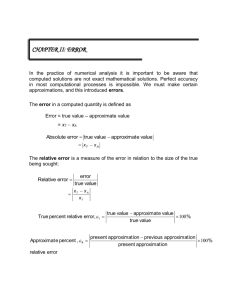

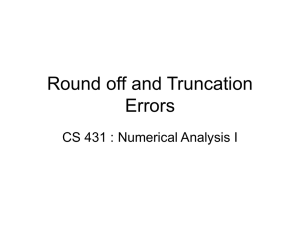
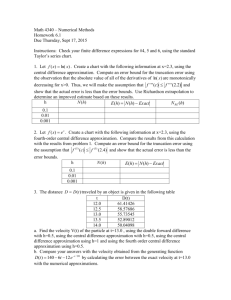


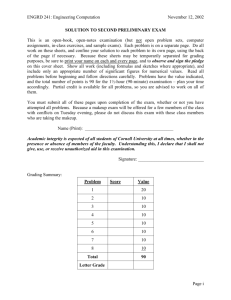

![1 = 0 in the interval [0, 1]](http://s3.studylib.net/store/data/007456042_1-4f61deeb1eb2835844ffc897b5e33f94-300x300.png)
